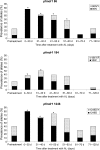Prolonged selection of pfmdr1 polymorphisms after treatment of falciparum malaria with artemether-lumefantrine in Uganda
- PMID: 21881128
- PMCID: PMC3164433
- DOI: 10.1093/infdis/jir486
Prolonged selection of pfmdr1 polymorphisms after treatment of falciparum malaria with artemether-lumefantrine in Uganda
Abstract
We compared the prevalence of key pfmdr1 alleles between pretreatment Plasmodium falciparum parasite isolates and parasites that emerged after treatment of uncomplicated malaria in a longitudinal cohort of Ugandan children. The pfmdr1 86N, 184F, and 1246D alleles were selected after treatment with artemether-lumefantrine, but not after artesunate-amodiaquine or amodiaquine-sulfadoxine-pyrimethamine. Remarkably, selection persisted in infections presenting up to about 60 days after treatment with artemether-lumefantrine. Thus, parasites selected for decreased drug sensitivity can appear long after predicted exposure to antimalarial drugs. Continued surveillance of the clinical efficacy and in vitro activity of new combination therapies is warranted.
Figures

Comment in
-
Dynamics of Plasmodium falciparum selection after artemether-lumefantrine treatment in Africa.J Infect Dis. 2012 May 1;205(9):1473-5; author reply 1475-6. doi: 10.1093/infdis/jis227. Epub 2012 Mar 27. J Infect Dis. 2012. PMID: 22454466 No abstract available.

